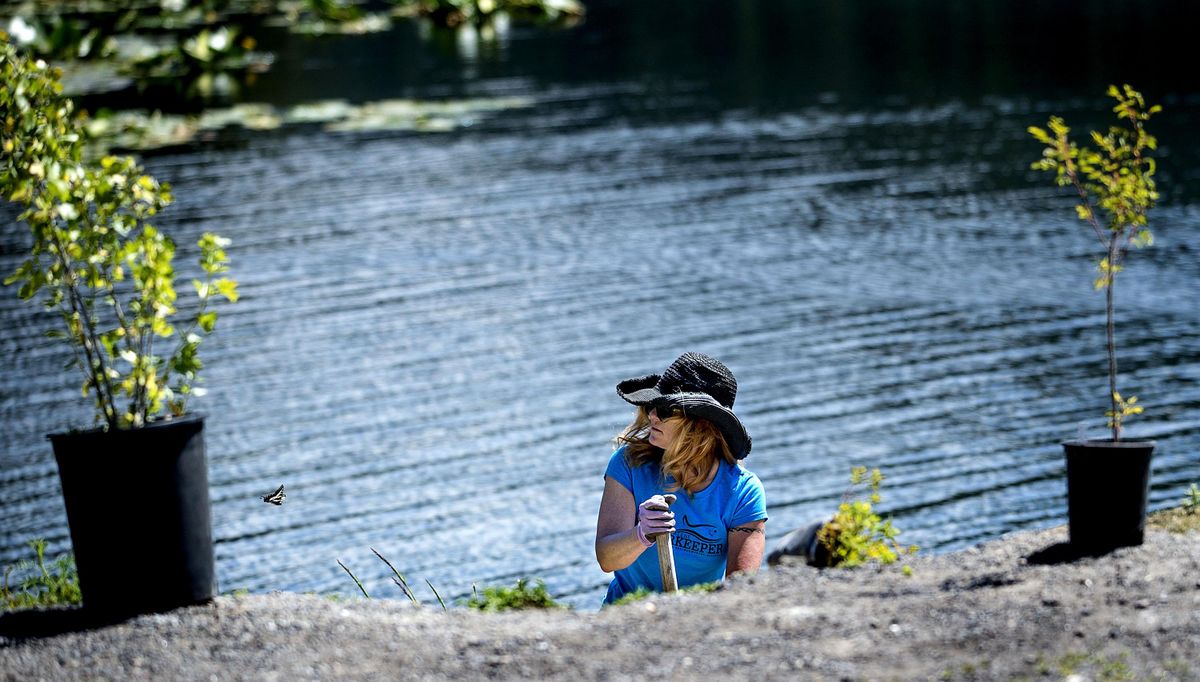Crews plant native shrubs at Fernan Lake to battle algae problems

Tristan Reasor used his shovel like a pickax Tuesday, hacking holes in the rocky embankment above Fernan Lake’s shoreline.
Service berry, mock orange and other hardy shrubs went into the holes. As they take root, the native plants will become the front line for keeping phosphorus out of the 381-acre lake.
The lake east of Coeur d’Alene is a popular destination for boaters and anglers, but it has frequent water quality problems, including prolonged toxic blue-green algae outbreaks that shut down swimming at the lake.
Reasor, a college intern, and others spent the morning planting shrubs for erosion control along the lake’s eastern shore. The project is a cooperative effort among Kootenai Environmental Alliance, Idaho Department of Environmental Quality and North Idaho College.
The embankment gets heavy foot traffic from anglers, which speeds up erosion.
“Bare soil is full of phosphorus,” said Adrienne Cronebaugh, KEA’s executive director. As the soil erodes into the lake, the phosphorus creates the conditions for blue-green algae to thrive.
With 90-degree weather in the forecast for the weekend, “I would expect to start seeing the blooms in the next few weeks,” she said.
Last year was a particularly bad one for blue-green algae outbreaks, which resemble scum on the water. At Fernan Lake, health advisories to avoid contact with the water started in late June and weren’t lifted until December. Other Inland Northwest lakes also experienced outbreaks.
Not all blue-green algae outbreaks produce toxins, but when they do, people can get upset stomachs from swallowing the water and skin rashes from contact. For pets and wildlife, ingesting the toxins can be fatal.
“We’re seeing an increase in the frequency and duration of the outbreaks in Fernan and other lakes,” said Robert Steed, a surface water ecologist for Idaho DEQ. “It’s not just local; it’s happening nationally and globally.”
Warmer temperatures heat up lakes earlier in the summer, while low snowpacks reduce the amount of water available to flush nutrients out of the lakes. Add a high phosphorous-to-nitrogen ratio, and the conditions line up for an outbreak, Steed said.
Phosphorus gets into Fernan Lake in a variety of ways, including runoff from rural residences’ pastures, lawn fertilizers and old Forest Service logging sites above the lake.
Fernan Lake Road’s reconstruction several years ago is also a factor. The work left bare road cuts and embankments that erode into the lake.
KEA received a $4,000 matching grant from Idaho DEQ to replant the area with native shrubs. North Idaho College is providing summer interns to help with the work, which will include hand-watering the plants this summer.
A pair of curious mallards paddled back and forth along the shoreline Tuesday morning, watching the work, while a bullfrog bellowed nearby. Anglers lined up with their fishing rods, and one couple brought their dog to swim in the lake.
KEA’s Cronebaugh encouraged the couple to watch for signs of blue-green algae as summer progresses, and avoid scummy looking areas.
Blue-green algae is an “attractive nuisance for dogs,” said Steed, the DEQ ecologist. “It smells bad and dogs pick up on that.”
As the native shrubs get established, they should help reduce conditions that create the outbreaks, Cronebaugh said.
“They’ll be grabbing the shoreline and keeping it intact,” she said.